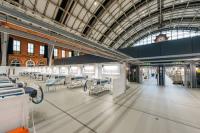 Add My Company
Add My Company
Sign In

Part one of our in-depth interview with Ged Couser of BDP. His harrowing story of how he coped with being infected with Covd-19 and how this has shaped his thinking on the future of infection prevention in healthcare and public buildings.
Also, how materials will need even more careful consideration in the way we think about the physical nature of our buildings.
Part two will discuss how healthcare and public buildings will need to adapt in the face of predicted future pandemic threats and what will be needed for a safer future.
Good Morning Ged, It’s great to be speaking with you and I’m very relieved you are recovering from your battle with Covid19. It’s good to have you back! How are you feeling?
Much better thanks, although it’s taken a while to get back up to how I felt before the infection. It was a very scary time.
As an architect, you’ve worked on many hospitals and healthcare facilities and of course the Nightingale wards - but you also have a unique perspective having suffered from COVID-19. Has it changed your view an everyday life?
Absolutely no question about it. When I got infected, I didn't take it that seriously at first – I thought I’d get get cold or flu symptoms at worst. My family all were infected, but as they were recovering, I got progressively worse and developed Covid Pneumonia. It brought my own mortality to front and centre.
I ended up in hospital despite being fit and healthy with no underlying conditions. My Oxygen saturation (which should be 95% or more usually) was 84% at one point, which is was quite bad really.
On my ward, people were leaving and were either going to the door on the left and home, or right towards critical care. I was in hospital for 4-5 days and for the first 24 hours, I didn't know whether I was going left..or right. The Consultant told me that no-one really knows why it affects some people badly, whilst others seem to be almost unaffected.
He also said that if you collected all the viruses particles that have infected everybody in world in one place - it would fill a Coke can. Just think about that for a moment.
When I was admitted, by a massive coincidence, in the next bed to me was Billy. He was my Mother-in-law's Uncle. He went to the right and sadly died a few weeks later.
It's real.
I think now everyone knows more people who've experienced it. First time around, it seemed so remote, but now we all seem more aware of people we know first hand suffering from it directly.
That’s a harrowing testimony Ged. I can only reiterate my gratitude that you’ve come through this and are back with us! But this must have influenced your thinking about hygiene & public health?
Trust me, having had it I will be that much more careful in the future! Covid infections are not going away and will be an ongoing problem.
As it’s often said, prevention is better than a cure. We have to be more vigilant and responsible about how we live our lives - and our attitude towards infection control. So far this disease has claimed the lives of over 2 million people worldwide.
In the healthcare sector, we work with people from healthcare trusts who used to be called 'infection control specialists’ They are now called 'infection prevention specialists' through CQC (Care quality Commission) processes. They are usually nurses who have hands on experience, they know what works
They know where cleaning is critical, where dirt and infection can lie dormant that can be a problem in the future.
How does the collaboration between BDP as Healthcare experts and NHS infection prevention specialists work?
First of all, this change in approach has meant that he incidence of hospital acquired infections is reducing dramatically because of their efforts.
Our work & design is reviewed by these people from masterplan and down through all scales: 1: 200 departmental planning to 1:50 loaded room plans down to 1: 5 and 1: 2 details. Every junction is considered, not just the materials, but the junctions between materials.
So infection prevention measures are involved at every level of detail. From the first line on a drawing, right up to a full size mock-up of a hospital bedroom built on site. So, they can ensure that we design hospitals and healthcare facilities together that promote infection prevention.
So the teams are aware of materials that actively prevent viral & bacterial infections?
Exactly – but it’s also how materials meet other materials. How the junctions are handled to prevent places where infections can hide. Scrutiny at every level, so details matter.
Any design approach, material or product that contributes to the infection prevention process is exactly what the market needs.
BDP is clearly a thought leader in healthcare design – you must be proud of your work in this area?
I am. BDP has always worked on hospitals, but over the last 20 years we worked on over 100 healthcare schemes.
We've been successful in being appointed to many of the new schemes going forward across the UK and on the basic infrastructure of the healthcare system: Alder Hey in Liverpool, QE2 hospital in Birmingham and recently Southmead hospital in Bristol. I think it’s fair to say we know what we are doing.
I am proud to play my part in the future of UK healthcare.
Image courtesy of BDP 2021©
Finally, can you tell us a bit about your work on the Nightingale hospitals? You went trough the role as lead architect, were isolated from your family for weeks, working night and day on the fast track building of the Nightingale wards. Only then you get the infection months afterwards!
When I first went to see the Greater Manchester Exhibition Centre with NHS and the Army, I looked at that vast, cavernous space. Whilst we were given the brief to deliver a CQC signed off hospital in two weeks.
Like most people, I didn't really understand the context of the true nature of the pandemic a year ago.
A fortnight later when I was walking out of the space, I saw 750 beds with high pressure oxygen, a proper hospital. I thought it was a great achievement for everyone involved.
But then I looked again and thought about 750 people so poorly, they didn't know whether they were going to live or die. It was the most scary thought. I realised that it could be truly catastrophic and depended so much on how society managed lockdown and social distancing.
I went for my Jab last week. Now we have a series of working vaccines really is almost miraculous.
But we still need to be vigilant. Infection prevention will be a key part of the future of controlling this awful, deadly virus.
Ged – Thank you so much for sharing your experience at the heart of this crisis.
For more information on A personal and professional portrait of surviving Covid-19, building the Nightingale hospitals and healthcare design talk to Be-Plas Hygienic Walls and Ceilings Ltd
Enquire Now
List your company on FindTheNeedle.

